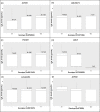Genetic associations between serum low LDL-cholesterol levels and variants in LDLR, APOB, PCSK9 and LDLRAP1 in African populations
- PMID: 32084179
- PMCID: PMC7034850
- DOI: 10.1371/journal.pone.0229098
Genetic associations between serum low LDL-cholesterol levels and variants in LDLR, APOB, PCSK9 and LDLRAP1 in African populations
Erratum in
-
Correction: Genetic associations between serum low LDL-cholesterol levels and variants in LDLR, APOB, PCSK9 and LDLRAP1 in African populations.PLoS One. 2021 Mar 26;16(3):e0249478. doi: 10.1371/journal.pone.0249478. eCollection 2021. PLoS One. 2021. PMID: 33770136 Free PMC article.
Abstract
Non-communicable diseases, including cardiovascular diseases (CVDs), are increasing in African populations. High serum low density lipoprotein cholesterol (LDL-cholesterol) levels are a known risk factor for CVDs in European populations, but the link remains poorly understood among Africans. This study investigated the associations between serum LDL-cholesterol levels and selected variants in the low density lipoprotein receptor (LDLR), apolipoprotein B (APOB), proprotein convertase subtilisin/kexin type 9 (PCSK9) and low density lipoprotein receptor adaptor protein 1 (LDLRAP1) genes in some selected African populations. Nineteen SNPs were selected from publicly available African whole genome sequence data based on functional prediction and allele frequency. SNPs were genotyped in 1000 participants from the AWI-Gen, study selected from the extremes of LDL-cholesterol level distribution (500 with LDL-cholesterol>3.5 mmol/L and 500 with LDL-cholesterol<1.1 mmol/L). The minor alleles at five of the six associated SNPs were significantly associated (P<0.05) with lower LDL-cholesterol levels: LDLRAP1 rs12071264 (OR 0.56, 95% CI: 0.39-0.75, P = 2.73x10-4) and rs35910270 (OR 0.78, 95% CI: 0.64-0.94, P = 0.008); APOB rs6752026 (OR 0. 55, 95% CI: 0.41-0.72, P = 2.82x10-5); LDLR: rs72568855 (OR 0.47, 95% CI: 0.27-0.82, P = 0.008); and PCSK9 rs45613943 (OR = 0.72, 95% CI: 0.58-0.88, P = 0.001). The minor allele of the sixth variant was associated with higher LDL-cholesterol levels: APOB rs679899 (OR 1.41, 95% CI: 1.06-1.86, P = 0.016). A replication analysis in the Africa America Diabetes Mellitus (AADM) study found the PCSK9 variant to be significantly associated with low LDL-cholesterol levels (Beta = -0.10). Since Africans generally have lower LDL-cholesterol levels, these LDL-cholesterol associated variants may be involved in adaptation due to unique gene-environment interactions. In conclusion, using a limited number of potentially functional variants in four genes, we identified significant associations with lower LDL-cholesterol levels in sub-Saharan Africans.
Conflict of interest statement
The authors have declared that no competing interests exist.
Figures



References
-
- World Health Organisation. Global Health Estimates 2016 Summary Tables: Deaths by cause, age and sex, by WHO region, 2000–2016 [Internet]. Geneva, Switzerland; 2018. Available: http://www.who.int/healthinfo/global_burden_disease/en/
Publication types
MeSH terms
Substances
Grants and funding
LinkOut - more resources
Full Text Sources
Research Materials
Miscellaneous

